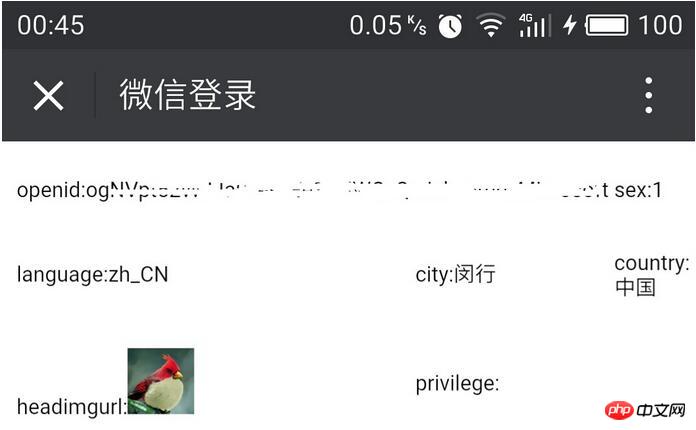 WeChat-Applet
WeChat-Applet
 WeChat-Entwicklung
WeChat-Entwicklung
 Das öffentliche .NET WeChat-Konto erhält eine OpenID- und Benutzerinformationsinstanzanalyse
Das öffentliche .NET WeChat-Konto erhält eine OpenID- und Benutzerinformationsinstanzanalyse
Das öffentliche .NET WeChat-Konto erhält eine OpenID- und Benutzerinformationsinstanzanalyse
In diesem Artikel wird hauptsächlich die Methode zum Abrufen von OpenID und Benutzerinformationen für das öffentliche .NET-WeChat-Konto vorgestellt, die für die Entwicklung der öffentlichen WeChat-Plattform besonders wichtig ist.
Das Beispiel in diesem Artikel teilt Ihnen die Methode zum Erhalten der Benutzer-OpenID auf der öffentlichen WeChat-Plattform als Referenz mit. Der spezifische Inhalt lautet wie folgt:
Index.aspx.cs-Code:
public partial class Index : System.Web.UI.Page
{
//用户id
public string openid = "";
//公众号信息部分
public string appid = ConfigurationManager.AppSettings["AppId"];
public string appsecret = ConfigurationManager.AppSettings["AppSecret"];
public string redirect_uri =HttpUtility.UrlEncode("http://www.jb51.net");
public string scope = "【删除这个并填入请求类型,例如:snsapi_userinfo】";
#region 显示页面
public string accesstoken;
public string nickname;
public string sex;
public string headimgurl;
public string province;
public string country;
public string language;
public string city;
public string privilege = "";
#endregion
protected void Page_Load(object sender, EventArgs e)
{
/*
*微信认证获取openid部分:
*临时认证code
*/
//微信认证部分:第二步 获得code
string code = Request["code"];
if (string.IsNullOrEmpty(code))
{
//如果code没获取成功,重新拉取一遍
OpenAccess();
}
//微信认证部分:第三步 获得openid
string url = string.Format("https://api.weixin.qq.com/sns/oauth2/access_token?appid={0}&secret={1}&code={2}&grant_type=authorization_code", appid, appsecret, code);
string result = HttpClientHelper.GetResponse(url);
LogHelper.WriteFile(result);
JObject outputObj = JObject.Parse(result);
//微信认证部分:第四步 获得更多信息
accesstoken = outputObj["access_token"].ToString();
openid = outputObj["openid"].ToString();
url = string.Format("https://api.weixin.qq.com/sns/userinfo?access_token={0}&openid={1}&lang=zh_CN",accesstoken,openid);
string result1 = HttpClientHelper.GetResponse(url);
LogHelper.WriteFile(result1);
JObject outputObj1 = JObject.Parse(result1);//将json转为数组
//以下是第四步获得的信息:
nickname = outputObj1["nickname"].ToString(); //昵称
sex = outputObj1["sex"].ToString(); //性别什么的
headimgurl = outputObj1["headimgurl"].ToString(); //头像url
province = outputObj1["province"].ToString(); ;
country = outputObj1["country"].ToString(); ;
language = outputObj1["language"].ToString(); ;
city = outputObj1["city"].ToString(); ;
//将获得的用户信息填入到session中
Session["openid"] = outputObj1["openid"];
//转向回入口
//OpenAccess();
}
/*
* 接入入口
* 开放到微信菜单中调用
* @param $dir_url 来源url
* @since 1.0
* @return void
*/
public void OpenAccess()
{
//判断session不存在
if (Session["openid"] == null)
{
//认证第一步:重定向跳转至认证网址
string url = string.Format("https://open.weixin.qq.com/connect/oauth2/authorize?appid={0}&redirect_uri={1}&&response_type=code&scope=snsapi_userinfo&m=oauth2#wechat_redirect", appid, redirect_uri);
Response.Redirect(url);
}
//判断session存在
else
{
//跳转到前端页面.aspx
Response.Redirect(Request.Url.ToString());
}
}
}Index.aspx-Inhalt:
<%@ Page Language="C#" AutoEventWireup="true" CodeBehind="Index.aspx.cs" Inherits="TEST.Index" %>
<!DOCTYPE html>
<html xmlns="http://www.w3.org/1999/xhtml">
<head runat="server">
<title></title>
<meta name="viewport" content="width=device-width, initial-scale=1" />
<style type="text/css">
td
{
word-wrap: break-word;
}
</style>
<script type="text/javascript">
</script>
</head>
<body>
<form id="form1" runat="server">
<p id="wu" runat="server">
<table style="width: 100%;">
<tr>
<td style="width: 150px;">
<p>
openid:<%=openid%></p>
</td>
<td>
<p>
nickname:<%=nickname%></p>
</td>
<td>
<p>
sex:<%=sex%></p>
</td>
</tr>
<tr>
<td>
<p>
language:<%=language%></p>
</td>
<td>
<p>
city:<%=city%></p>
</td>
<td>
<p>
country:<%=country%></p>
</td>
</tr>
<tr>
<td>
<p>
headimgurl:<img src="/static/imghw/default1.png" data-src="<%=headimgurl % alt="Das öffentliche .NET WeChat-Konto erhält eine OpenID- und Benutzerinformationsinstanzanalyse" >" class="lazy" width="50px;" alt=""></p>
</td>
<td>
<p>
privilege:<%=privilege%></p>
</td>
<td>
</td>
</tr>
</table>
</p>
</form>
</body>
</html>HttpClientHelper.cs-Code:
public class HttpClientHelper
{
/// <summary>
/// get请求
/// </summary>
/// <param name="url"></param>
/// <returns></returns>
public static string GetResponse(string url)
{
if (url.StartsWith("https"))
{
ServicePointManager.SecurityProtocol = SecurityProtocolType.Tls;
}
var httpClient = new HttpClient();
httpClient.DefaultRequestHeaders.Accept.Add( new MediaTypeWithQualityHeaderValue("application/json"));
HttpResponseMessage response = httpClient.GetAsync(url).Result;
if (response.IsSuccessStatusCode)
{
string result = response.Content.ReadAsStringAsync().Result;
return result;
}
return null;
}
public static T GetResponse<T>(string url)
where T : class, new()
{
if (url.StartsWith("https"))
ServicePointManager.SecurityProtocol = SecurityProtocolType.Tls;
var httpClient = new HttpClient();
httpClient.DefaultRequestHeaders.Accept.Add(
new MediaTypeWithQualityHeaderValue("application/json"));
HttpResponseMessage response = httpClient.GetAsync(url).Result;
T result = default(T);
if (response.IsSuccessStatusCode)
{
Task<string> t = response.Content.ReadAsStringAsync();
string s = t.Result;
result = JsonConvert.DeserializeObject<T>(s);
}
return result;
}
/// <summary>
/// post请求
/// </summary>
/// <param name="url"></param>
/// <param name="postData">post数据</param>
/// <returns></returns>
public static string PostResponse(string url, string postData)
{
if (url.StartsWith("https"))
ServicePointManager.SecurityProtocol = SecurityProtocolType.Tls;
HttpContent httpContent = new StringContent(postData);
httpContent.Headers.ContentType = new MediaTypeHeaderValue("application/json");
var httpClient = new HttpClient();
HttpResponseMessage response = httpClient.PostAsync(url, httpContent).Result;
if (response.IsSuccessStatusCode)
{
string result = response.Content.ReadAsStringAsync().Result;
return result;
}
return null;
}
/// <summary>
/// 发起post请求
/// </summary>
/// <typeparam name="T"></typeparam>
/// <param name="url">url</param>
/// <param name="postData">post数据</param>
/// <returns></returns>
public static T PostResponse<T>(string url, string postData)
where T : class, new()
{
if (url.StartsWith("https"))
ServicePointManager.SecurityProtocol = SecurityProtocolType.Tls;
HttpContent httpContent = new StringContent(postData);
httpContent.Headers.ContentType = new MediaTypeHeaderValue("application/json");
var httpClient = new HttpClient();
T result = default(T);
HttpResponseMessage response = httpClient.PostAsync(url, httpContent).Result;
if (response.IsSuccessStatusCode)
{
Task<string> t = response.Content.ReadAsStringAsync();
string s = t.Result;
result = JsonConvert.DeserializeObject<T>(s);
}
return result;
}
/// <summary>
/// V3接口全部为Xml形式,故有此方法
/// </summary>
/// <typeparam name="T"></typeparam>
/// <param name="url"></param>
/// <param name="xmlString"></param>
/// <returns></returns>
public static T PostXmlResponse<T>(string url, string xmlString)
where T : class, new()
{
if (url.StartsWith("https"))
ServicePointManager.SecurityProtocol = SecurityProtocolType.Tls;
HttpContent httpContent = new StringContent(xmlString);
httpContent.Headers.ContentType = new MediaTypeHeaderValue("application/json");
var httpClient = new HttpClient();
T result = default(T);
HttpResponseMessage response = httpClient.PostAsync(url, httpContent).Result;
if (response.IsSuccessStatusCode)
{
Task<string> t = response.Content.ReadAsStringAsync();
string s = t.Result;
result = XmlDeserialize<T>(s);
}
return result;
}
/// <summary>
/// 反序列化Xml
/// </summary>
/// <typeparam name="T"></typeparam>
/// <param name="xmlString"></param>
/// <returns></returns>
public static T XmlDeserialize<T>(string xmlString)
where T : class, new()
{
try
{
var ser = new XmlSerializer(typeof (T));
using (var reader = new StringReader(xmlString))
{
return (T) ser.Deserialize(reader);
}
}
catch (Exception ex)
{
throw new Exception("XmlDeserialize发生异常:xmlString:" + xmlString + "异常信息:" + ex.Message);
}
}
}Das Ergebnis sieht wie folgt aus:

Das obige ist der detaillierte Inhalt vonDas öffentliche .NET WeChat-Konto erhält eine OpenID- und Benutzerinformationsinstanzanalyse. Für weitere Informationen folgen Sie bitte anderen verwandten Artikeln auf der PHP chinesischen Website!

Heiße KI -Werkzeuge

Undresser.AI Undress
KI-gestützte App zum Erstellen realistischer Aktfotos

AI Clothes Remover
Online-KI-Tool zum Entfernen von Kleidung aus Fotos.

Undress AI Tool
Ausziehbilder kostenlos

Clothoff.io
KI-Kleiderentferner

Video Face Swap
Tauschen Sie Gesichter in jedem Video mühelos mit unserem völlig kostenlosen KI-Gesichtstausch-Tool aus!

Heißer Artikel

Heiße Werkzeuge

Notepad++7.3.1
Einfach zu bedienender und kostenloser Code-Editor

SublimeText3 chinesische Version
Chinesische Version, sehr einfach zu bedienen

Senden Sie Studio 13.0.1
Leistungsstarke integrierte PHP-Entwicklungsumgebung

Dreamweaver CS6
Visuelle Webentwicklungstools

SublimeText3 Mac-Version
Codebearbeitungssoftware auf Gottesniveau (SublimeText3)




